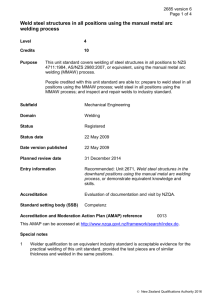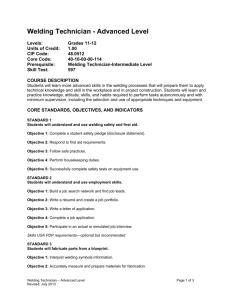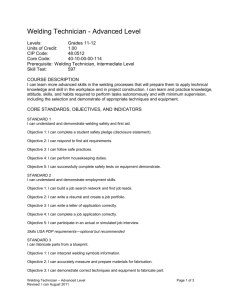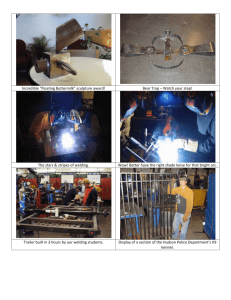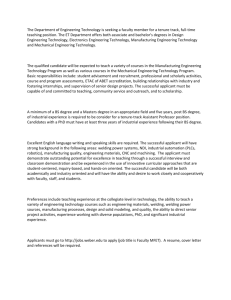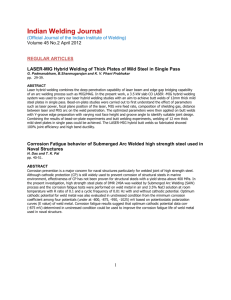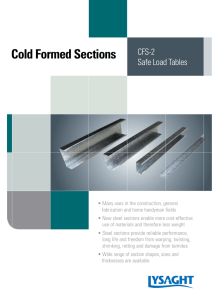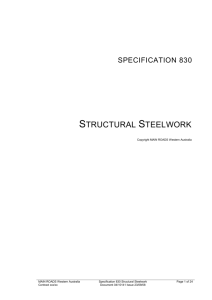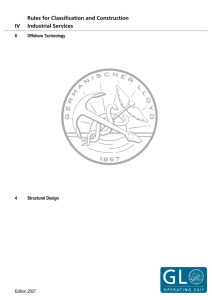2681 Weld steel structures using the submerged arc welding
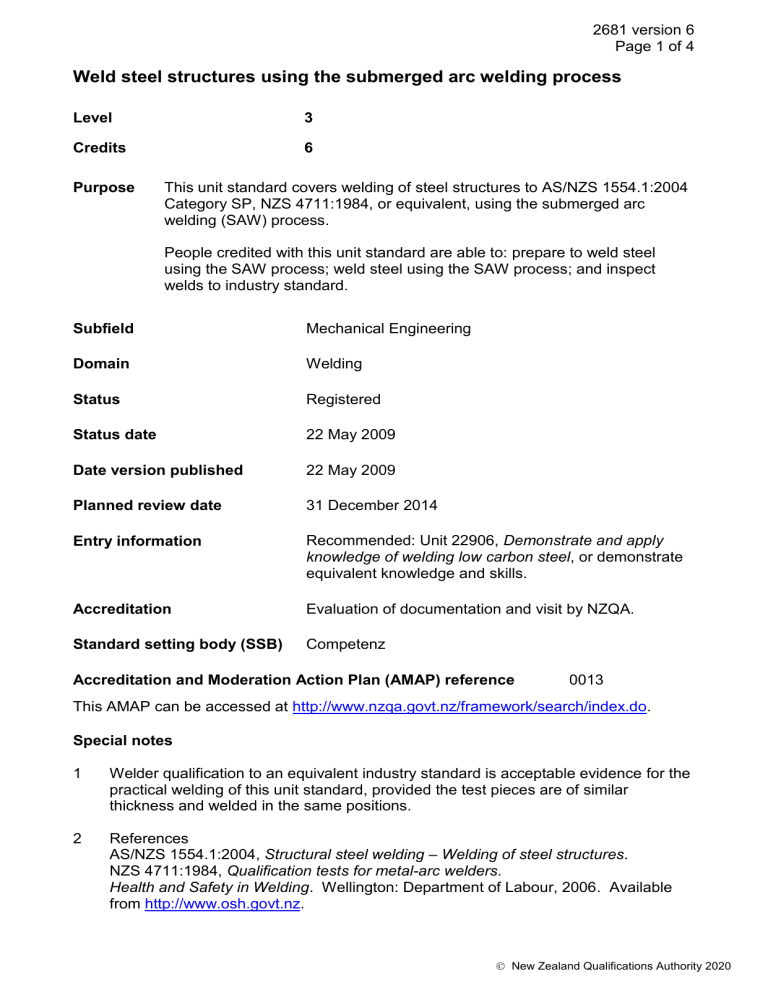
2681 version 6
Page 1 of 4
Weld steel structures using the submerged arc welding process
Level 3
Credits 6
Purpose This unit standard covers welding of steel structures to AS/NZS 1554.1:2004
Category SP, NZS 4711:1984, or equivalent, using the submerged arc welding (SAW) process.
People credited with this unit standard are able to: prepare to weld steel using the SAW process; weld steel using the SAW process; and inspect welds to industry standard.
Subfield Mechanical Engineering
Domain
Status
Status date
Date version published
Planned review date
Entry information
Welding
Registered
22 May 2009
22 May 2009
31 December 2014
Recommended: Unit 22906, Demonstrate and apply knowledge of welding low carbon steel , or demonstrate equivalent knowledge and skills.
Accreditation Evaluation of documentation and visit by NZQA.
Standard setting body (SSB) Competenz
Accreditation and Moderation Action Plan (AMAP) reference 0013
This AMAP can be accessed at http://www.nzqa.govt.nz/framework/search/index.do
.
Special notes
1 Welder qualification to an equivalent industry standard is acceptable evidence for the practical welding of this unit standard, provided the test pieces are of similar thickness and welded in the same positions.
2 References
AS/NZS 1554.1:2004, Structural steel welding – Welding of steel structures .
NZS 4711:1984, Qualification tests for metal-arc welders .
Health and Safety in Welding from http://www.osh.govt.nz
.
.
Wellington: Department of Labour, 2006. Available
New Zealand Qualifications Authority 2020
2681 version 6
Page 2 of 4
3 Definitions
Industry practice
– refers to the safe and sound practices accepted by the fabrication industry .
Industry standard – refers to AS/NZS 1554.1:2004, NZS 4711:1984, or equivalent.
SAW – Submerged Arc Welding.
Steel
– refers to low-carbon unalloyed (carbon-manganese) steels or low alloyed steels, which are widely used for structural applications in industries such as road and rail transport, shipbuilding, machinery, and construction.
Welding procedure
– refers to a written work instruction providing all the necessary technical detail for a specific welding application.
Elements and performance criteria
Element 1
Prepare to weld steel using the SAW process.
Performance criteria
1.1 Work area is assessed for hazards associated with the SAW process and all necessary precautions taken in accordance with safe working practice.
Range electric shock, fire, explosion, fumes and gases, heat, confined space.
1.2 Equipment is selected to meet welding procedure requirements.
Range power source – rating, duty cycle, open circuit voltage, current type; wire feed system; flux feed system; welding cables; travel unit where appropriate.
1.3 Equipment is assembled and maintained ready for use in accordance with manufacturer ’s instructions.
1.4 Steel is prepared and assembled in accordance with welding procedure.
Range preparation is limited to – cleaning, providing root face where required, tack welding to correct alignment.
1.5 Electrode and flux are selected in accordance with welding procedure.
New Zealand Qualifications Authority 2020
2681 version 6
Page 3 of 4
Element 2
Weld steel using the SAW process.
Range 1G position, approximately 12 mm thickness.
Performance criteria
2.1 Safety procedures are followed and personal protective equipment is worn in accordance with safe working practice.
2.2 Electrodes are stored and handled in accordance with specifications. manufacturer’s
2.3 Welds are deposited on steel to industry standard and in accordance with welding procedure.
2.4
Element 3
Welds are cleaned in accordance with industry practice.
Inspect welds to industry standard.
Performance criteria
3.1 Weld imperfections are identified by visual examination and workshop tests.
Range workshop tests
– nick break, fillet break-over, bend, macro examination. Evidence of two tests is required.
3.2 Weld imperfections are compared to the permissible levels allowed by industry standard.
Please note
Providers must be accredited by NZQA, or an inter-institutional body with delegated authority for quality assurance, before they can report credits from assessment against unit standards or deliver courses of study leading to that assessment.
Industry Training Organisations must be accredited by NZQA before they can register credits from assessment against unit standards.
Accredited providers and Industry Training Organisations assessing against unit standards must engage with the moderation system that applies to those standards.
Accreditation requirements and an outline of the moderation system that applies to this standard are outlined in the Accreditation and Moderation Action Plan (AMAP). The
AMAP also includes useful information about special requirements for organisations wishing to develop education and training programmes, such as minimum qualifications for tutors and assessors, and special resource requirements.
New Zealand Qualifications Authority 2020
2681 version 6
Page 4 of 4
Comments on this unit standard
Please contact Competenz qualifications@competenz.org.nz address if you wish to suggest changes to the content of this unit standard.
New Zealand Qualifications Authority 2020

